Snakes can be quite scary, which is why they come up time and again in the symbology of different cultural traditions around the world. They’re reptiles with no legs, and various versions live everywhere except in Antarctica and the arctic circle.
There are over 4,000 species of snakes worldwide, and some people are so scared of snakes that they panic if they find one nearby. We know they can be scary, but which ones are the weirdest? We will look at some snakes so strange that it’s hard to believe they’re real.
9. Sunbeam Snakes (Xenopeltis spp.)
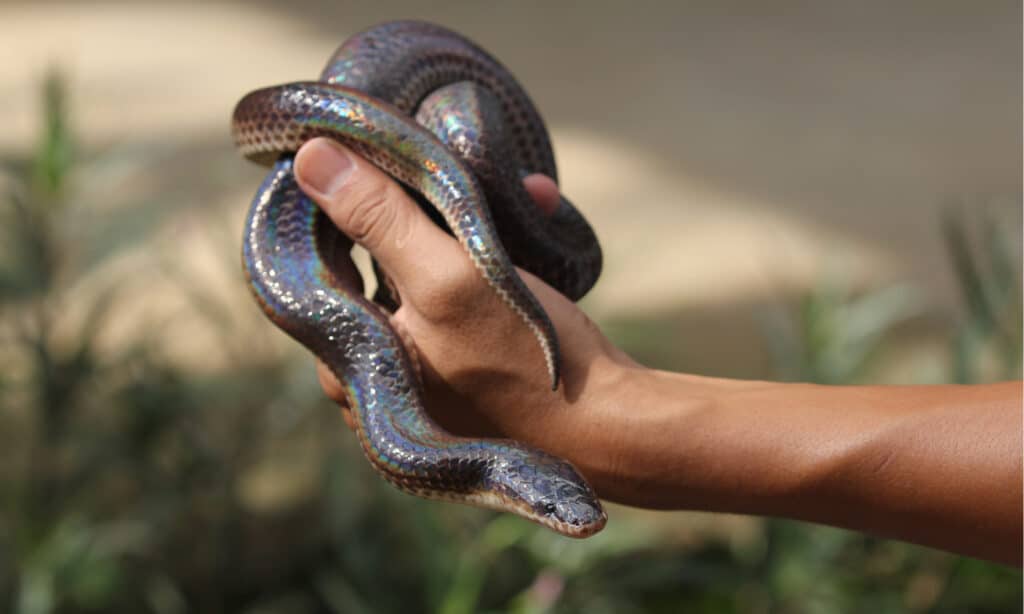
The sunbeam snake looks like it’s covered in an oil slick.
©Mufti Adi Utomo/Shutterstock.com
While sunbeam snakes are kept as pets by some people and aren’t as rare as some of the other snakes on this list, that doesn’t make them less fiction-like. When the sun hits their scales just right, coloring much like a directional oil spill appears.
Sunbeam snakes live in Asia, and their rainbow appearance makes them seem fantastic. They are very much real, however. A menagerie of colors can be seen under the right circumstances. When the sun isn’t making them dazzle, they have a dark appearance.
Another weird attribute on top of the sunbeam snake’s appearance is that it rattles its tail like a rattlesnake when it feels threatened. There isn’t anything that rattles on that tail, but it’s interesting that this defense mechanism developed in such distantly related snakes.
It’s hard to admire their beauty because they spend most of their time in burrows that they create. It is possible to own these weirdly iridescent serpents, but only experienced people should give it a go. That’s because they need a special substrate to burrow in, and they have very specific temperature requirements.
8. Tiger Keelback (Rhabdophis tigrinus)
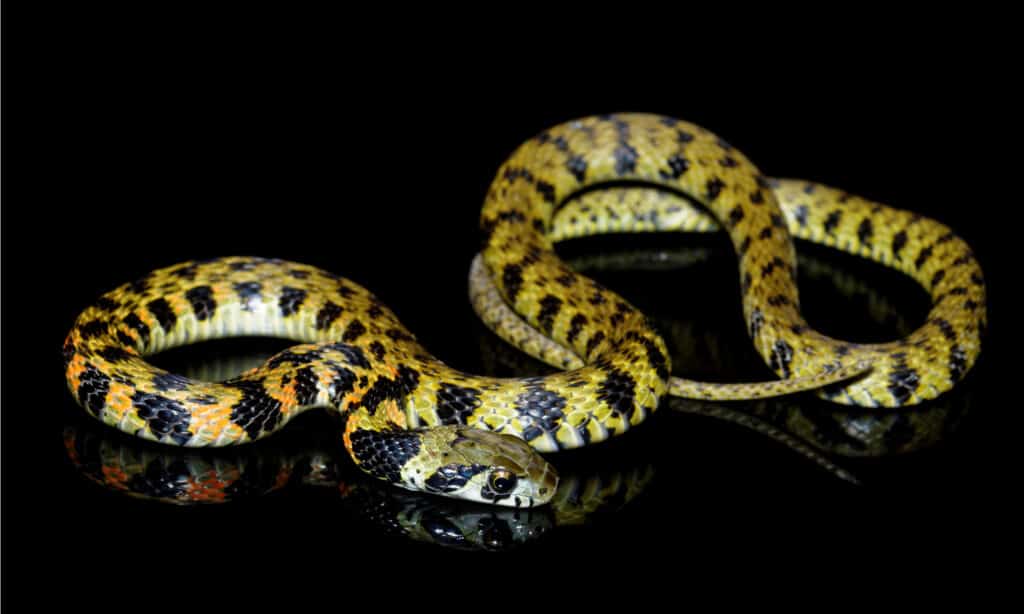
The
tiger
keelback can eat poisonous toads and use the second-hand juice on its prey.
©Valt Ahyppo/Shutterstock.com
While these snakes may look normal, they can pack a venomous punch capable of killing a child. However, they’re not very aggressive, so they don’t cause much damage to the human population. Tiger keelbacks are from east Asia, most notably Japan.
In a display that would make even an eastern hognose snake jealous, tiger keelbacks write around and flatten their necks just like the hognoses. What seems too weird to be true is how a tiger keelback can eat poisonous toads, store the poison in glands, and reuse it when it feels threatened. This snake can squirt second-hand toad juice on its prey. Not only is that gross, it feels like someone made it up. Nope. Tiger keelbacks are real.
7. Blue Viper (Trimeresurus insularis)
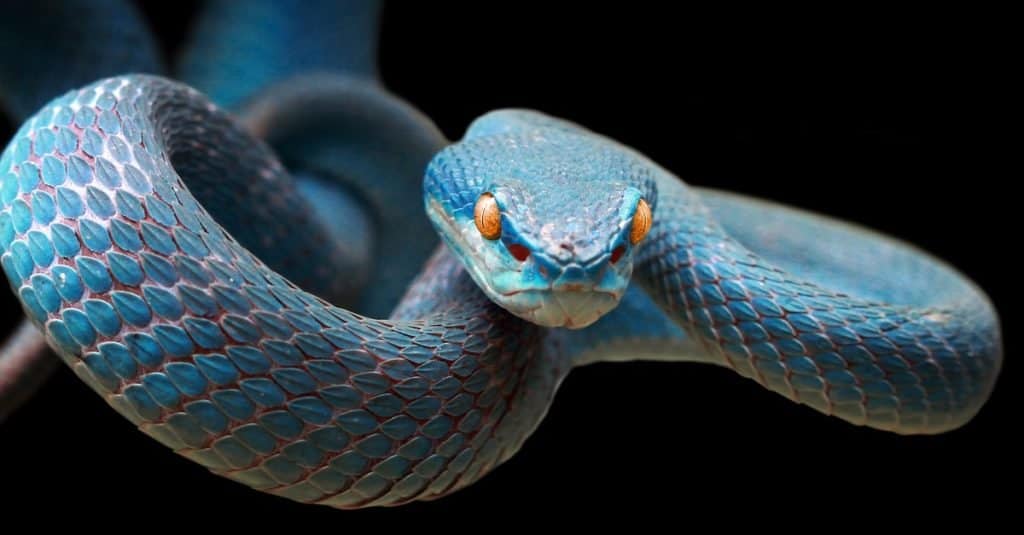
The blue viper is beautiful and menacing.
©Kurit afshen/Shutterstock.com
The blue viper is mesmerizing in its turquoise coloring, but it’s best if you refrain from approaching it. The snake looks almost like jewelry, not like the venomous reptile it is.
It’s venomous, and when it’s in cities, it’s known to cause some of the most painful bites you can get from snakes that live near the streets. Its venom causes extreme complications as it can cause flesh necrosis and severe internal and external bleeding.
The blue pit viper is a variation of the white-lipped island viper found on only a few islands in Indonesia. There are also rare yellow snakes of this type a little journey away, though they aren’t as weirdly beautiful as the blue viper. Most white-lipped island vipers are green, which is boring compared to these diamonds in the rough.
It’s hard to believe that a slithering snake can be so beautiful, and it’s very weird that such a juxtaposition would exist. The blue viper is strange but very real.
6. Malagasy Leaf-Nosed Snake (Langaha madagascariensis)

The Venomous Malagasy leaf-nosed snake has a weird plant-like protrusion on its face.
©reptiles4all/Shutterstock.com
A leafy stick-like head makes the leaf-nosed snake one of the weirdest looking snakes on the planet. It’s hard to believe that something so fragile-looking is real, but this snake exists in Madagascar’s rainforests. The leaf-nosed snake mainly eats lizards, and while it is venomous, its painful bite is not fatal to humans.
Females and males look very different even though they still have one of the weirdest snake attributes sticking off their heads. The horn on a male is pointed while the horn on a female looks more leaf-shaped. Both genders have different colorations as well.
5. Rhinoceros Rat Snake (Gonyosoma boulengeri)

Rhino snakes are common in Southeast Asia and have a horn-like projection from the tip of their nose.
©Eric Isselee/Shutterstock.com
This snake has a protrusion from its nose that looks eerily like a rhinoceros‘ horn. Nobody knows why this mini snake horn exists, but it’s a real thing, if not a bit odd. It almost looks like a unicorn’s horn, but the rhino moniker is distinct enough. This snake is also known as the Vietnamese longnose snake.
The rhinoceros rat snake lives in southern China and northern Vietnam and is nonvenomous. This horned snake lives amongst the trees and is usually active at night. It has a specific elevation that it inhabits as it lives in rainforests that are between roughly 1000 to 3500 feet in elevation. This snake grows more than 4 feet in length.
4. Butterfly Viper (Bitis nasicornis)
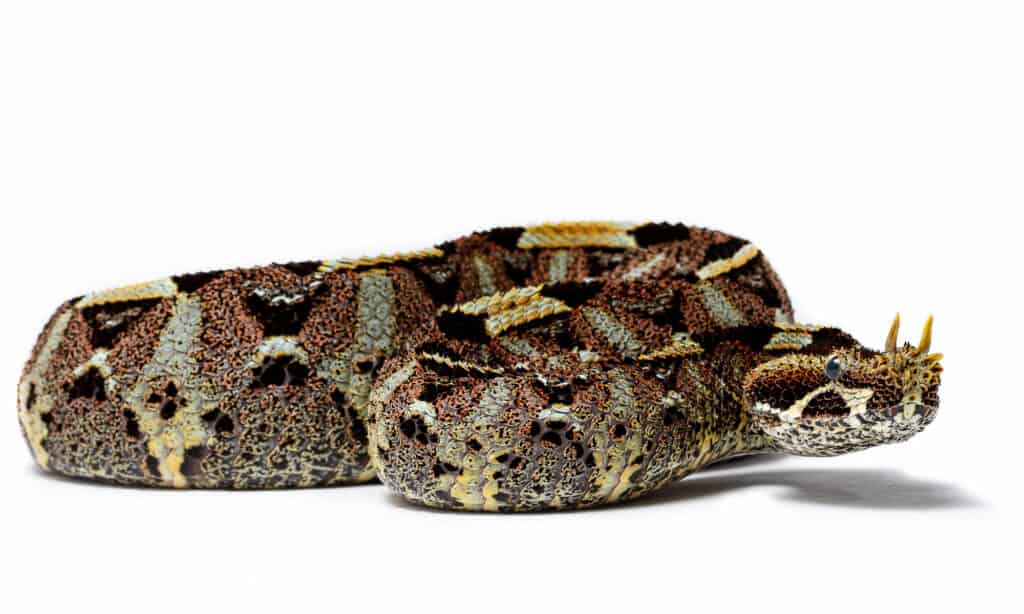
The rhinoceros viper has a weird two-horned face.
©Scott Delony/Shutterstock.com
There’s an unrelated viper species that also have a protrusion on their nose for reasons unknown. This snake is called the butterfly viper and is often confused with the previous snake on our list.
Instead of having one horn like the rhinoceros rat snake, the butterfly viper has two horns and can grow quite a bit larger. The butterfly viper grows to about four feet in length. Its horns are above its nostril, almost like it’s ready to go to a rock concert.
Another attribute of the butterfly viper that makes it a weirdo contender is that it puffs up to twice its size when it feels threatened. This snake belongs to a family of snakes that do this, called the puff adder.
These snakes are highly venomous, and it doesn’t take much of their venom to do serious damage. Their venom destroys blood vessels and tissues causing internal bleeding.
3. Elephant Trunk Snake (Acrochordus javanicus)
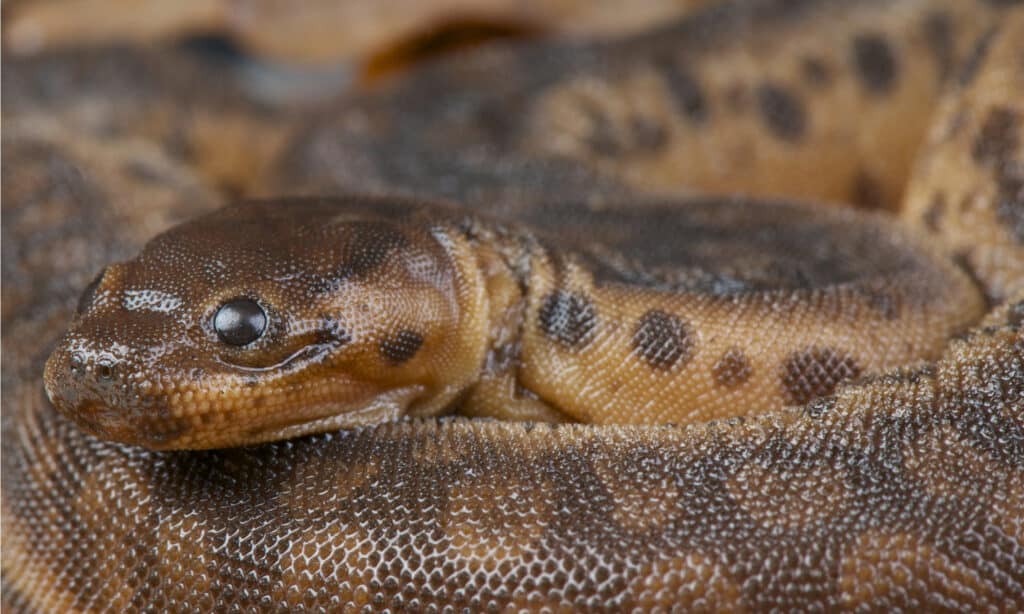
The elephant trunk snake looks just like its namesake.
©reptiles4all/Shutterstock.com
The elephant trunk snake lives in southeast Asia and is sometimes called a Javan file snake. The way its loose skin gathers up in parts makes this snake look strangely like an elephant’s trunk. This snake is a lot like a boa constrictor, and females may reach 8 feet in length.
Elephant trunk snakes are aquatic snakes and only come up on land if something catastrophic occurs. Their baggy skin has sharp scales on it that are meant to ensnare fish in the river habitat. They coil around their prey with the help of their scales to kill it before eating it.
This baggy snake can’t really look like an elephant’s trunk, right? The elephant trunk snake does indeed look just like an elephant’s trunk, though a trunk from an elephant and an elephant trunk snake work in very different ways and for widely different purposes.
It’s weird but real that two unrelated things would evolve into visual twins.
2. Thread Snake (Leptotyphlopidae spp.)
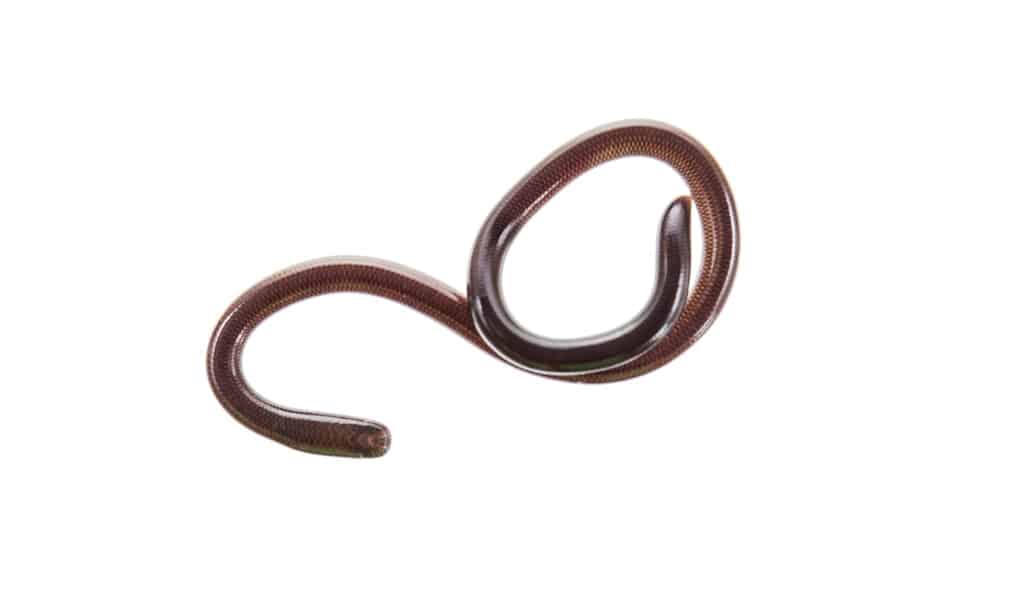
The thread snake might easily be mistaken for an earthworm, and can comfortably curl up on a U.S. quarter.
©somyot pattana/Shutterstock.com
At a max of 4 inches long, the thread snake, also known as the blind snake, is the smallest in the world. This little snake makes a meal out of ant larvae, termite larvae, and other critters of that size that it can find in dirt.
The smaller the snake is, the bigger its offspring is in relation to the adult body. A female thread snake will lay one egg, and the egg will hatch into a baby thread snake that’s half as long as its parent.
Thread snakes are blind. These earthworm-looking snakes are originally found in Africa and Asia. Their undeveloped eyes are covered with scales rendering them visionless. They’ve made it around the world in soil which is a reason another name for them is the flowerpot snake.
The blind snake is a burrowing snake, so it doesn’t need any vision to go about most of its daily activities. At night it rises to the surface to search for its prey.
Snakes like the Brahimy blindsnake in Florida didn’t show up until the 1970s. Versions of blind snakes also exist in southeastern Australia and almost all tropical and subtropical parts of the world.
Being a snake-worm is weird, but it’s a reality for these tiny little critters.
1. Hairy Bush Viper (Atheris hispida)
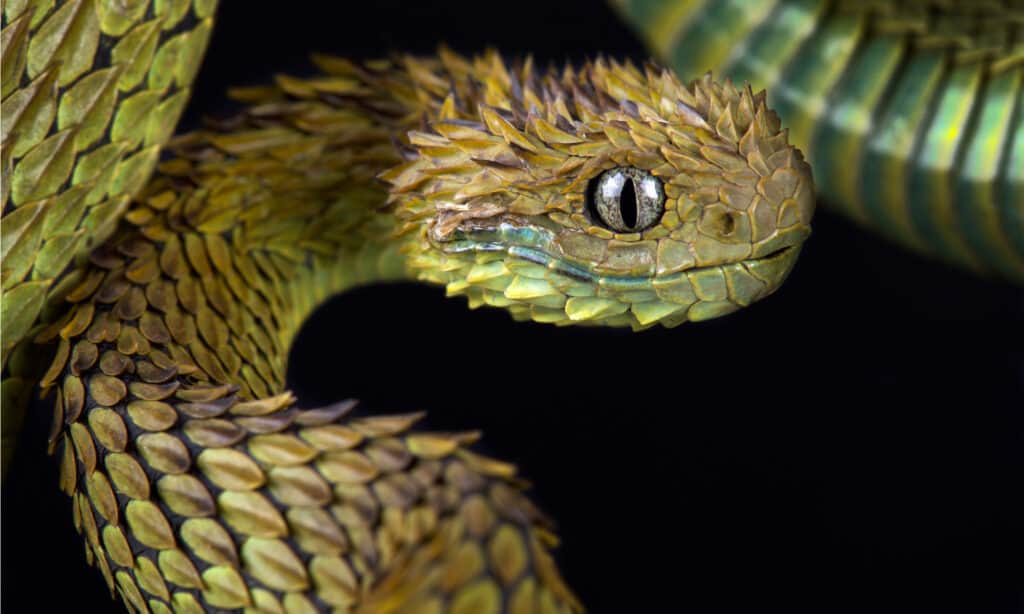
The hairy bush viper looks like it spikes its hair.
©reptiles4all/Shutterstock.com
The hairy bush viper lives in Tanzania, Uganda, Kenya, and Congo. It is about 2 feet in length with some variance. It is also known as the spiny bush viper and the scaled bush viper.
Hairy bush vipers look like they’ve spiked their hair since their scales don’t lay smoothly on top of each other like with other snake species. Nobody is sure why they rock their puffed-out scales, but it’s believed it’s because they’re trying to match their habitat in a unique way. Either way, it looks pretty weird.
This snake also has a prehensile tail which allows it to hang upside down and hold on to things while it meanders around the trees in its range. It is venomous, which makes it not only weird but dangerous. Only one bite can kill an animal and put a human at great risk. Its venom is a neurotoxin that also causes hemorrhaging in various organs. So even though it looks like it’s ready for a party, it’s best not to go near it.
So, what we have here is a snake that looks like a dragon? It seems too weird to be real, but the hairy bush viper fits the bill.
The photo featured at the top of this post is © reptiles4all/Shutterstock.com
Discover the "Monster" Snake 5X Bigger than an Anaconda
Every day A-Z Animals sends out some of the most incredible facts in the world from our free newsletter. Want to discover the 10 most beautiful snakes in the world, a "snake island" where you're never more than 3 feet from danger, or a "monster" snake 5X larger than an anaconda? Then sign up right now and you'll start receiving our daily newsletter absolutely free.
Thank you for reading! Have some feedback for us? Contact the AZ Animals editorial team.






